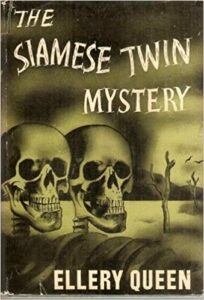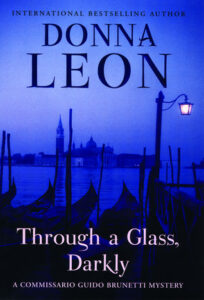I don’t believe in ghosts, but I love the idea of the dead communicating with the living in a fiction. In a traditional mystery, it’s up to a brilliant detective to follow a trail of clues around a death and then deduce who the murderer is—think of Hercule Poirot bragging about his “little grey cells.” As satisfying as that construct can be, it sometimes leaves me feeling like the murder victim is the character who matters least in a novel. The reader rarely meets them and often has no insight into what made them tick. Their death is simply the engine that powers the story, ultimately showcasing a sleuth’s dazzling skills.
For me, there’s always been a powerful attraction to making the dead character at the center of the story come alive for readers. In the past, I’ve done that through flashbacks, but in my latest book, Her Last Breath, I use a different strategy: the main character, Deirdre, receives a letter from her dead sister, Caroline in chapter one. Before that, no one even suspects Caroline’s accidental death could be a murder. But after learning that her sister was married to a man who’d killed his first wife, Deirdre isn’t just hell-bent on getting justice, but on understanding why her sister chose to keep the secrets she did.
We have a tradition of not speaking ill of the dead, but bringing victims to life on the page changes that dynamic. Their awareness of their impending mortality implies that they knew that they were involved with something dangerous, immoral, or even illegal —and yet they had to carry on until their untimely end. Through letters or diaries—or in showing how the victim suspected death was close and chose to prepare for it—they can become flawed characters we understand and even sympathize with.
Here are a few novels I love for the way they allow the murder victim to “speak” for themselves and to affect the course of the investigation of their own murder. (Caution: some mild spoilers ahead, but I’ve been careful never to give too much of the plot away.)

The Siamese Twin Mystery by Ellery Queen
Ask me to name my favorite traits in a murder victim, and at the top of the list is one who refuses to go easily. That’s what you find in this classic mystery. While it’s of course up to Ellery Queen to solve the murder—with the help of his father and a gruff police inspector—the most intriguing character is Dr. John Xavier, shot dead while playing solitaire. It’s the rare victim with the presence of mind to find the right card and tear it while he’s bleeding out, but that’s what the good doctor does. If you’re an Ellery Queen fan, you know that he uses this clue-from-the-victim-as-they-are-dying construct in multiple books—but never again so cleverly as this one.

A Trace of Smoke by Rebecca Cantrell
When reporter Hannah Vogel finds her brother’s photograph in Berlin’s Hall of the Unnamed Dead, she’s reluctant to make a formal identification. It’s not that she doesn’t love her brother, but it’s 1931 and Ernst had a controversial career as a cross-dressing performer in a glittering cabaret. As Hannah quietly investigates, messages from Ernst surface in some unlikely places, including her own jewelry box, where her brother had hidden a priceless ring. Turns out, Ernst was having an affair with a high-ranking Nazi officer, so he took certain precautions, including mailing Hannah a packet of their love letters—giving her information and ammunition.

Behind Every Lie by Christina McDonald
If you think you’ve had a bad day, meet Eva Hansen, who was struck by lightning on the same night her mother was murdered. Not only does Eva suffer from amnesia, but the police suspect that she killed her mother. The truth is, Eva and her mother have always had a difficult relationship, so even Eva questions whether she might’ve done it. But everything changes when she finds a note her mother wrote on the day she died, revealing family secrets Eva never suspected. While the note doesn’t name her killer, it reorients the investigation, putting Eva on a path that looks crazy to the investigating officer yet leads her to the truth.

The Decagon House Murders by Yukito Ayatsuji
This is a mystery classic in Japan, for good reason. Playing with an Agatha Christie set-up reminiscent of And Then There Were None, the story brings seven members of the Kyoto University Mystery Club to an island to study an unsolved multiple murder that occurred a year earlier. They stay in Decagon House—a curiously designed building with a central hall and ten identical doors leading from it—because the other house on the island is a burned-out ruin. When the first club member dies, the others realize they’re being targeted. But there’s a diabolical twist, with letters written by Nakamura Seiji, the architect of Decagon House, being delivered to two club members who opted not to visit the island, accusing the entire club of murder. However, Nakamura was one of the murder victims from a year earlier…

Dead Certain by Adam Mitzner
Is everyone living a double life in this crime novel? Yes, starting with the main character, Ella Broden. By day, she was an overworked attorney working on intense cases; by night, she’s a singer in some seedy clubs. The same is true of her sister, Charlotte, a writer who is very secretly juggling multiple affairs. When Charlotte vanishes after selling her first novel, Ella discovers that her sister’s book is in large part a diary, in which her real-life experiences are chronicled behind pseudonyms. Little as she knew about her sister’s life, Ella is the only person who can crack the code.

Through a Glass, Darkly by Donna Leon
What I said about the murder victim being rendered into the least interesting character? That goes double for any book about Commissario Guido Brunetti, with whom we wander through a slowly sinking Venice, enjoying sumptuous meals, for more than a hundred pages before the crime occurs. But the murder of Tassini, a clumsy night watchman recently hired by a Murano glass factory (readers never even get his first name), becomes engaging when a copy of Dante’s Inferno turns up, annotated by the dead man. Those notes reveal what Tassini was really doing at the plant and point to his killer.

Murder in G Major by Alexia Gordon
You don’t need to believe in ghosts to be charmed when they appear in novels. The first in the Gethsemane Brown series introduces a classical musician stranded in the Irish countryside. Not only is she a talented teacher, but she has an uncanny ability to connect with ghosts—one of which she finds in a cliffside cottage. Eamon McCarthy was believed to have murdered his wife and killed himself, but his ghost insists that he didn’t—and he needs Gethsemane to find out who did. (If you think ghosts have all the answers in the afterlife, you’re mistaken.) Eamon may be dead, but he’s snarky as can be, and his partnership with Gethsemane to find the truth is a delight.
***


















